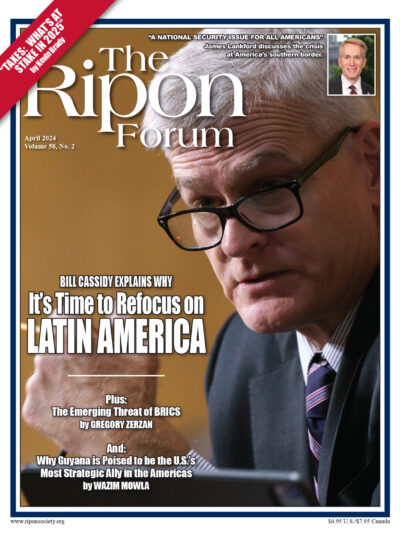
U.S. tax policy is between a rock and a hard place. In less than two years, the majority of Americans are in for a rapid tax hike unless Congress acts. But eye-popping government debt and all-time-high deficits severely constrain lawmakers’ options.
First, the rock: major portions of the 2017 Tax Cuts and Jobs Act (TCJA), which cut business and individual income taxes and reformed the international tax system, are set to expire at the end of 2025. Because the law reduced average tax burdens for all income levels, most people will feel the effects, either through less money in their pockets or fewer jobs to choose from — or both. For example, a single worker with no kids making $75,000 per year would see a tax increase of $1,700.
In 2022, the overall tax burden on an average single worker in the U.S. with $70,170 in pre-tax income was $21,380 — a 30.5 percent tax wedge. While the average tax burden in the U.S. has consistently remained below the Organization for Economic Cooperation and Development (OECD) average for over two decades (by 4 percentage points in 2022), the TCJA expirations would directly increase the tax wedge faced by most workers and put a serious dent in America’s advantage.
In 2022, the overall tax burden on an average single worker in the U.S. with $70,170 in pre-tax income was $21,380 — a 30.5 percent tax wedge.
Making the TCJA permanent would maintain America’s advantage and increase GDP by 0.5 percent, employment by 686,000 full-time equivalent jobs, and after-tax incomes by 2.4 percent on average over the next decade.
Sounds great. Why can’t Congress just do that? Because extending the entire reform would come with a $3.7 trillion price tag — something the U.S. cannot afford. The federal government’s debt is $33 trillion and deficits just reached the highest in U.S. history (nearly $2 trillion) outside of the pandemic years.
According to the International Monetary Fund (IMF), the U.S. federal government is among the most indebted governments in the world, and the problem is only getting worse because spending growth is outpacing revenue growth.
Rock, meet hard place.
So, what should Congress do to prevent an unwanted tax hike that will hurt the economy and people’s pocketbooks without making the country’s precarious fiscal situation worse?
Lawmakers must prioritize policies that come with the biggest “bang for the buck.” In other words, what tax changes will come with the most economic growth for the lowest cost?
Some tax cuts create a larger economic boost than others. One metric is to compare the estimated change in long-run GDP to the estimated change in annual tax revenue in the final year of the budget window (a proxy for the ongoing, long-run cost of a policy change).
The most powerful provision under this metric is full expensing for business investment in equipment — meaning businesses can write off the cost of their investments in the year they are made — followed by expensing for research and development costs. By removing the penalties on investment, the U.S. would get more of it, thereby growing the U.S. economy.
Lawmakers must prioritize policies that come with the biggest “bang for the buck.” In other words, what tax changes will come with the most economic growth for the lowest cost?
Another metric is the way tax changes impact debt-to-GDP. A more pro-growth tax cut will increase debt-to-GDP to a smaller degree than a similarly sized but less efficient tax cut. For instance, the debt-to-GDP effect of lowering individual income tax rates and widening the tax brackets falls by about 40 percent dynamically (taking economic growth into account) compared to conventionally (excluding economic growth). The difference of a less pro-growth tax change, such as expanding the standard deduction, is just 1.4 percent.
On the other hand, the debt-to-GDP effect of full expensing reverses. The decreases in long-run revenue are very small compared to the increase in long-run economic output such that full expensing reduces the long-run debt-to-GDP ratio by 0.3 percentage points. Full expensing, therefore, is the most efficient way to use the tax code to boost economic growth.
The TCJA’s expiration may be a threat to the U.S. economy, but it’s also an opportunity: lawmakers have a chance to rewrite the tax code. But Congress must thread the needle, promoting growth and opportunity without worsening U.S. debt. The end of 2025 may seem like the distant future, but it is critical lawmakers start acting now. Our country’s economic future—and American pocketbooks — depends on it.
Daniel Bunn is the President and CEO of the Tax Foundation, a nonpartisan tax policy think tank in Washington, D.C.




